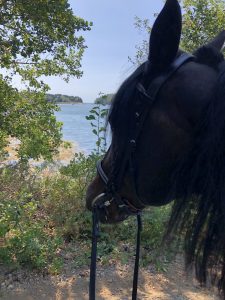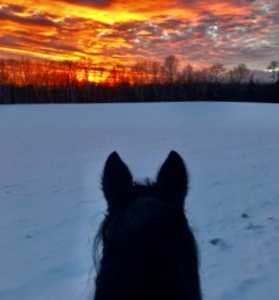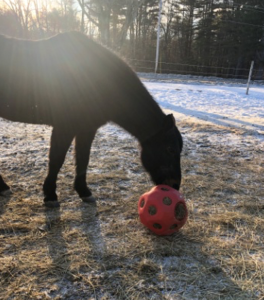
Debbie Hight at the 2022 BHPS
Editor’s Note:
This week, we hear from Debbie Hight. She is a former BHPS board member, horse owner, and occasional guest columnist for Cayuse Communications. She writes from her home in Maine, where she cares for dogs and horses, especially her lovely Morgan mare, Roxy, who was a demonstration horse at the Summit in Maine in 2019. She writes about hind gut concerns and has been lent a hand by Dr. Sheryl King. This is Part II of two parts.

Roxy and Debbie explore the Maine coast
Debbie writes:
Last winter, I was looking forward to spring and to the end of my 25-year-old Morgan mare’s hind gut issues, less romantically called, the “squirts.” It’s a phenomenon that has developed over the past three winters: looser manure and occasional “squirting.”
The first year, I blamed it on her taking a bite of decorative bittersweet. My vet thought otherwise and told me that in older horses, the hind gut is not as efficient and looser manure and squirting results. (Fecal Water Syndrome or Cushings Disease are not concerns). She didn’t think that it bothered horses unless it affected their tail or skin.
I noted that my mare tended to drink more water and lick more salt in the winter. The vet simply said that she was replacing fluids and minerals. The issue magically disappears each spring. By the end of last winter, I had seen an improvement with restricting the amount of salt that she gets, as well as a daily dose of pre- and pro-biotics. The plan was to continue the pre- and pro-biotics throughout the non-winter months to see if it contributed to a more constant gut biome.
 I maintained the two-scoop-a-day pre- and pro-biotics throughout the summer and fall. November came and with it, the return of the squirts. Now what? I had just returned from the Best Horse Practices Summit in Lexington, KY where Dr. Sheryl King had presented on “The Origins and Management of Gut Trouble in Horses,” with a focus on colic and ulcers. Sheree was involved in my quest to understand Roxy’s issues last winter and her excellent and approachable presentation left me with the following understanding:
I maintained the two-scoop-a-day pre- and pro-biotics throughout the summer and fall. November came and with it, the return of the squirts. Now what? I had just returned from the Best Horse Practices Summit in Lexington, KY where Dr. Sheryl King had presented on “The Origins and Management of Gut Trouble in Horses,” with a focus on colic and ulcers. Sheree was involved in my quest to understand Roxy’s issues last winter and her excellent and approachable presentation left me with the following understanding:
- Horses salivate only when chewing, which lets the hay slide down easier. Saliva contains bicarbonate, which is a natural buffer that acts to neutralize stomach acid.
- A horse takes 40 minutes and chews 3500-4500 times to consume a small flake of hay, whereas two pounds of oats requires only about 850 chews in 10 minutes… Thus, a diet heavy in grain reduces buffering capacity in the stomach.
- Ulcer-inducing factors include intermittent feed/water, confinement, grain and pelleted feed, NSAIDs, and stress. (None of these factors apply to Roxy.)
- Hindgut microbial fermentation allows a horse to live on grass. 60-70% of a horse’s energy requirement should come from hindgut fermentation of fibrous feeds.High fiber ingesta conserves microbes.
- Optimal digestive health often comes from continuous hut fill from grazing grass or hay.
- Roughage, roughage, roughage! (That’s Roxy’s diet.)
- Feed grain and concentrates as sparingly as possible. (Roxy gets none.)
- Water, water, water! (Roxy is a great water drinker.)
- Change feeds gradually. (Roxy’s diet never changes.)
- Exercise stimulates gut motility but can also promote ulcers when performed at speed for prolonged periods. (Roxy gets about 20 minutes of mild exercise each day.)
- Practice routine dental care. (Roxy gets an annual dental exam.)
- Have fecal egg counts performed and deworm according to results. (Roxy has this done twice a year.)

Roxy and the Hay Ball. A short-lived trial in slow-feeding
The biggest factor seemed to be a lack of constant grazing. Because she is a Morgan mare with a cresty neck, amd had a brief bout of laminitis (before I owned her), I have taken her diet seriously and limited her turnout to a ‘sacrifice pasture.’
She is allowed some grass pasture for maybe 30 minutes a week during the summer, but otherwise is in the sacrifice pasture. During non-winter months, she “grazes” throughout the day on occasional sprigs of grass here and there. No runny manure!
She gets hay nets when she is stalled at night, but for logistical reasons, I am unable to do that during the day. Porta-Grazers looked like an interesting idea, but I dismissed them because of cost. I found a Hay Ball, a dodecahedron-shaped plastic ball to provide her “hours of grazing.” She learned to pin it against the barn and emptied it immediately. A sixty-dollar flop.
My answer then is to feed her four times a day when I am around and able to.
Despite all my box-checking, she was still squirting this winter. While my vet said the squirts don’t bother my horse, I was beginning to think otherwise. She can be grumpy when I carefully cinch her girth and she sometimes moves her hind legs in a minor kicking action when she farts.
I watched a long video by Dr. Ben Sykes on YouTube. He called it an “Unhappy Hind Gut” and an undifferentiated inflammatory bowel of unknown cause.
My next experiment, prompted by Sheree’s suggestion, was bentonite clay. Like any good horse owner, I consulted Dr. Google for dosing: one ounce per day. It has been touted as an “elixir” capable of removing unspecified toxins and I had once used it with Roxy after a surgery years ago.
Things gradually improved! After a month, her manure was quite normal.
Hooray! But why?
According to Sheree and my vet, clay probably binds up extra water. Researchers noted that perhaps some of the components of the clay acted like Kaopectate. (See link below.) It may also help with pH stabilization, buffering capacity, absorption of possible toxins.
I am still perplexed by Roxy’s runny manure only occurring during the winter months. What changes for her in winter?
— I am planning on having my soil tested in the sacrifice pasture.
— There is some information suggesting that the microbiome affects insulin production, so I will also have her ACTH and Insulin numbers checked winter and summer. To date, those numbers have been in the normal range.
There are a million supplements out there to treat hind gut issues. But the science of fundamental gut health is well captured by Dr. King:
- constant forage
- water
- exercise.
I guess that “Winter Squirts: Part III” will be coming next winter!
With continued gratitude for the education and patience of Dr. King, to BHPS for its focus on science, and to my buddy, Roxy.
References
King, Dr. Sheryl. “The Origins and Management of Gut Trouble in Horses” Keynote Best Horse Practices Summit, Lexington KY. October 2022
Clay Minerals in Animal Nutrition
Dr. Ben Sykes, “Unhappy Hind Gut” video.
Thanks for this. My mare has always tended to have loose manure, especially when stressed, but also had the constant dribble. Pre biotics, pro biotics, etc., etc. Nothing helped until, even though she got no grain, I did Dr. Jeff Tucker’s No Grain Challenge, after hearing him interviewed by Maddy on the podcast. My mare is also ALWAYS hungry. We call her Hoover. For 9 months or so I added a cup of soybean meal to her supplements. At first, having the protein (our hay here is rather low in protein and for the same reasons as you she cannot be on pasture. She will literally eat herself to death.) I saw an immediate improvement in mood and “hunger.” That didn’t last forever though. Over the months however, I did see better stool formation and the elimination of the dribbling.
Eventually I withdrew the soybean meal, as it seemed to be causing inflammation. The dribbling has not returned. It’s an ongoing battle with weight, inflammation, constant hunger (forget “free feeding”), etc. I have to supplement my other mare, because Hoover doesn’t step away from the hay bag until it is all, totally gone. Feeding 3x a day seems to help as well.